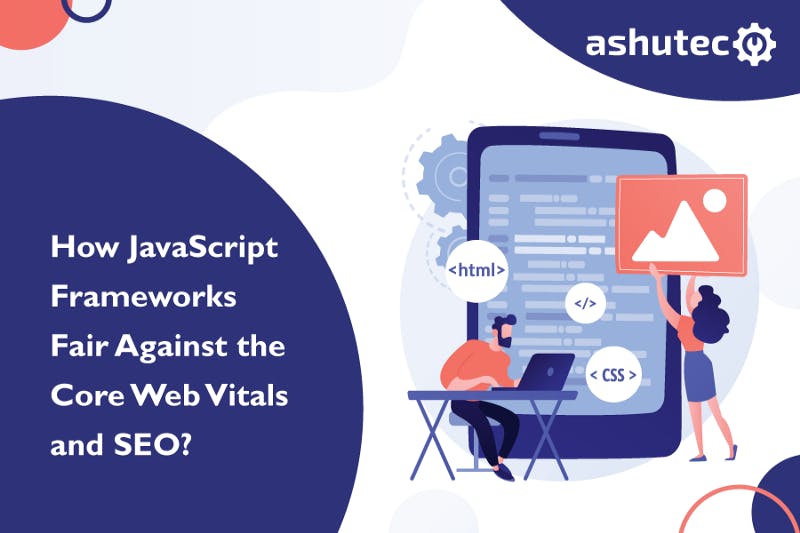Let’s Connect!
Work can be a fun when we know and understand each other well. Let's start conversation to new beginning
+91 63542 35108
To discuss what we can do for you Give us a Call
connect@ashutec.com
Tell us about your next project Write to us

The web giant — Google brings many updates and in the latter half of 2020, it introduced Core Web Vitals. Core Web Vitals comprise the frontend page experience signals to measure the loading performance (LCP), interactivity (FID), and visual stability (CLS).
JavaScript or frameworks based on the language play an important part in the frontend development to offer an improved experience to users. Frameworks make life easier for frontend developers to build highly interactive and responsive frontends of web applications.
Since the JavaScript frameworks play an important role, it remains to see how they perform and fair against the Core Web Vitals and best SEO practices. There are tons of frameworks built on top of JavaScript or its spinoff version TypeScript. Frameworks like React, Angular, and others make the web experience richer and more interactive.
But to get to know how they fair against Core Web Vitals, we’d have to go deep into understanding the JavaScript and Core Web Vitals. So, let’s first start with the Core Web Vitals and understand what they are.
As per Google, Core Web Vitals and Web Vitals are the best available signals to measure the quality of user experience across the web. Core Web Vitals apply to all the web pages and each represents a critical facet of the user experience. They also reflect the real-world experience of user-centric outcomes.
Core Web Vitals comprise LCP (Largest Contentful Paint), FID (First Input Delay), and CLS (Cumulative Layout Shift). Here’s a short brief about each Core Web Vital:
LCP: LCP measures the loading performance of the web pages. For providing a good user experience LCP should take place within 2.5sec when the page starts loading.
FID: FID measures the interactivity of the page. Pages should have a 100 ms or less FID for offering a good user experience.
CLS: CLS measures the visual stability of pages and should have 0.1 or less for a good user experience.
Core Web Vitals are one of the critical metrics to deliver a great user experience. Also, there are other web vitals that impact the user experience. Web Vitals such as Time to First Byte and First Contentful Paint both represent vital aspects of the loading experience and also help diagnose issues with LCP.
Now enough about the Core Web Vitals, let’s understand how JavaScript frameworks fair against these Core Web Vitals and SEO.
JavaScript is an end-user-oriented language more than it is developer-oriented. It uses the computations resources of end-users to power their experience through the browsers. This enables them to show richer content and make the experience more vibrant for users.
However, most JavaScript frameworks have been designed with the mindset to help developers to be productive, ship code faster, eliminate complex concept implementation, and many other things. Such frameworks simplify the syntax and coding structure by leveraging object-oriented programming.
So, in essence, JavaScript language is concerned with providing a great experience to end-users but frameworks based on the language are developed with the developer mindset. Thus, there is much room for evolution for these frameworks to become end-user-oriented.
These frameworks should be designed and engineered to offer a richer, faster, lighter, and computationally cost-efficient experience.
Modern frameworks such as React and Angular have been utilized to build real-time and reactive web frontend applications. They follow the best practices and guidelines for search engine optimization and perform well to offer a rich user experience.
However, the question that still remains is — are these frameworks beneficial to the end-users when we consider the usage of computational resources, storage, and network bandwidth. The future of these JS-based frameworks should be focused on being less memory intensive, less storage space, and using less network bandwidth.
Since the Search Engine giants like Google favors faster web applications with less voracious in network bandwidth, storage, and computational resources. This states the direction of JS-based frameworks that needs to be user-centered and effectively tackle reactiveness and interactivity. They are well prepared to compete against the Core Web Vitals to offer a lighter and faster experience to end-users.
Since Google is heading towards the direction of offering faster loading content through Core Web Vitals, JavaScript and frameworks based on it should concern themselves with offering faster and lighter experience. In addition to React and Angular, new frameworks such as Svelte and Inferno promises to deliver the intended experience.
Further, every JS framework should also concern and be sure to focus on these Core Web Vitals and criteria to offer a rich user experience. As the JS frameworks play an important role in offering a faster and lighter experience, websites with a large chunk of traffic coming from Google will have to rethink about their web frontend engineering.
Google continues to enhance its JavaScript indexing capabilities and has become far more advanced today than ever. Also, React and Angular 2.0 have native support for server-side rendering, which leaves no room for Ajax crawl directive and other 3rd party rendering services to improve.
Server-Side Rendering is known to improve SEO performance and SEO-friendly frameworks such as React and Angular are competent enough for SEO and overall performance. Here’s a more detailed guide on Server-Side Rendering and what JS frameworks support such type of rendering.
In the end, we just want to say that this is a less technical exploratory guide that explains how JS frameworks fair against the Core Web Vitals and SEO. The JavaScript frameworks were designed with the developer mindset but gradually they are transcending towards providing rich and more interactive performance.

